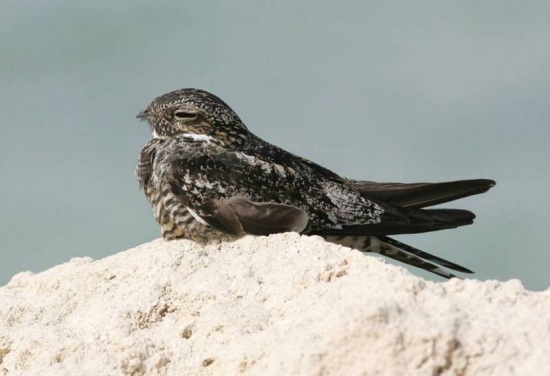| Line 1: | Line 1: | ||
;Chordeiles gundlachii | ;Chordeiles gundlachii | ||
| − | [[Image:Antillean_Nighthawk.jpg|thumb| | + | [[Image:Antillean_Nighthawk.jpg|thumb|550px|right|Photo by NIGHTJAR1<br/>Male photographed in New Providence, Bahamas.]] |
==Description== | ==Description== | ||
The Antillean Nighthawk, Chordeiles gundlachii, is a nightjar. | The Antillean Nighthawk, Chordeiles gundlachii, is a nightjar. | ||
Revision as of 11:28, 2 July 2007
- Chordeiles gundlachii
Description
The Antillean Nighthawk, Chordeiles gundlachii, is a nightjar.
The adults are dark with brown, grey and white patterning on the upperparts and breast; the long wings are black and show a white bar in flight. The tail is dark with white barring; the underparts are white with black bars. The adult male has a white throat; the female has a light brown throat. The most distinguishing characteristic to determine its identity from its closest relative the Common Nighthawk are the contrasting pale tertials near the back of the wings of a sitting bird. There are 2 color morphs, a gray and a rufous type.
Identification
The Antillean Nighthawk is very similar to the Common Nighthawk; see external links below for a discussion of the differences between the two.
Distribution and Taxonomy
Antillean Nighthawk is known from the Greater Antilles, the Bahamas and Southern Florida, especially the Keys and Tortuga. However, recently they have been demonstrated to breed in e.g., Guadeloupe of the Lesser Antilles. The Antillean Nighthawk migrates out of its breeding range after raising its young. It still remains unknown where the birds spend the winter. The birds in Florida and the Bahamas are supposed to be a different subspecies (vicinus) from the rest of the region. The Antillean Nighthawk was until recently thought to be the same species as Common nigthhawk.
Habitat
Mainly belong in open country. They usually nest on bare ground, sometimes in raised locations including stumps or gravel roofs. They especially favor recently cleared areas in forests, airport fields, cane fields and pastures, but can also utilize gravel pits.
Behavior
They catch flying insects on the wing, mainly foraging near dawn and dusk (crepuscular) or sometimes at night with a full moon.
The two eggs are laid directly on bare ground--there is no nest. Incubation is performed largely by the female and lasts for about 20 days. Young fledge at about 20 days of age.
Voice
The call is a short pikadik usually heard overhead. The Common Nighthawk occasionally will make a similar call, but it is not as consistent




